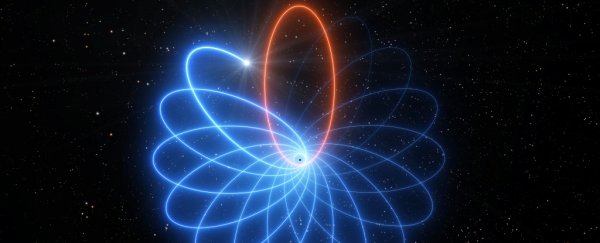A single star called S2 looping around the supermassive black hole in the centre of our galaxy just demonstrated a prediction of general relativity in the most extreme environment we can test it in - putting yet another feather in the theory's already bristling cap.
Putting together decades worth of observations, astronomers have shown that S2's orbit isn't a fixed-in-position ellipse; rather, the orbit shifts around like a spirograph drawing - a phenomenon known as Schwarzschild precession.
This is the first time Schwarzschild precession has been detected around a supermassive black hole, demonstrating that it holds true even when we observe the orbits of stars in the most gravitationally extreme environment.
In addition, general relativity equations can be used to accurately predict the orbital changes - and these calculations have precisely matched up with the observations of S2.
"Einstein's general relativity predicts that bound orbits of one object around another are not closed, as in Newtonian gravity, but precess forwards in the plane of motion," explained astrophysicist Reinhard Genzel of the Max Planck Institute for Extraterrestrial Physics (MPE) in Germany, and member of the GRAVITY Collaboration.
"This famous effect - first seen in the orbit of the planet Mercury around the Sun - was the first evidence in favour of general relativity. One hundred years later we have now detected the same effect in the motion of a star orbiting the compact radio source Sagittarius A* at the centre of the Milky Way."

S2 swoops around Sagittarius A* on a long, elliptical orbit every 16 years. At its closest approach, or periastron, it comes within 17 light-hours of the black hole, or just over four times the distance from the Sun to Neptune.
That may sound far, but when you're dealing with something as massive as Sagittarius A*, it's amazingly close, and the gravitational kick from the black hole speeds the star up to nearly 3 percent of the speed of light as it swings around. It's one of the closest-orbiting stars in the galactic centre.
And this is not S2's first relativity rodeo. Astronomers have been closely watching the star since the 1990s. In 2018, the GRAVITY Collaboration announced that the way S2's light stretched as it came close to Sagittarius A* was confirmation of an effect predicted by general relativity in one of its most extreme tests yet. The following year, a second team confirmed these results with their own paper, written using an independent set of observations.
Now, the GRAVITY Collaboration has used over 330 measurements from observations dating back to 1992 up until the end of 2019 to see if the observed precession matches predictions made by general relativity. And they hit paydirt.
"After following the star in its orbit for over two and a half decades, our exquisite measurements robustly detect S2's Schwarzschild precession in its path around Sagittarius A*," said astrophysicist Stefan Gillessen of MPE.
But that's not all. In order to calculate the precession of S2, an accurate mass is required for Sagittarius A*. So far, the evidence points to a mass of around 4 million times the mass of the Sun. In order to fit the observed orbit, the relativity equations also required a mass of around 4 million times the mass of the Sun.
This is yet another confirmation of the mass of Sagittarius A*. And it also allows astronomers to study the space around the orbit, too. For instance, if another massive object, such as an intermediate-mass black hole, were nearby, it would influence the orbit. Not finding those orbital influences means we can constrain what's in the galactic centre.
"Because the S2 measurements follow general relativity so well, we can set stringent limits on how much invisible material, such as distributed dark matter or possible smaller black holes, is present around Sagittarius A*," said astrophysicists Guy Perrin and Karine Perraut of the Observatoire de Paris-Site de Meudon and the Observatoire de Grenoble in France, respectively.
"This is of great interest for understanding the formation and evolution of supermassive black holes."
All that, from just one star. How wonderful.
The research has been published in Astronomy & Astrophysics.
